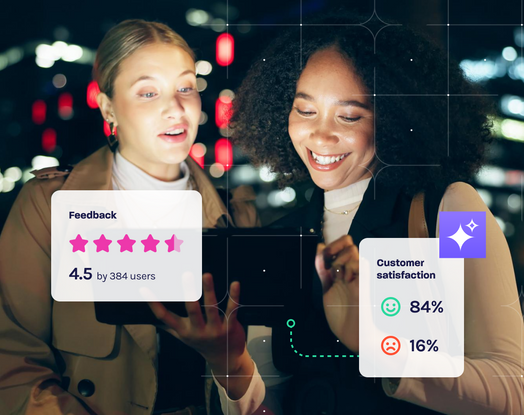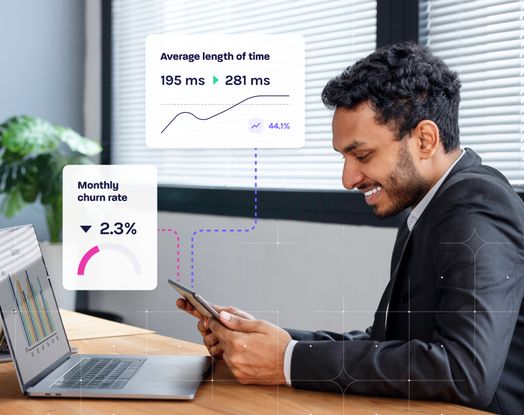
Artificial Intelligence Fraud Detection in Banking
Banks lose billions annually to fraud, and traditional systems can’t keep up. Meanwhile, criminals are more sophisticated than ever, deploying identity theft, account takeovers, phishing and money laundering schemes that can slip past outdated defenses.
You need more than static filters or manual reviews to protect your institution’s reputation and bottom line. That’s why artificial intelligence has emerged as the new standard for real-time threat prevention.
Glassbox brings unique capabilities and solutions in AI-powered fraud detection by helping banks surface hidden signals and suspicious user behaviors before they escalate into costly attacks. Our approach lets you detect anomalies in digital sessions, flag dangerous activity and stay one step ahead of fraudsters. Keep reading to see how you can leverage AI fraud detection in your financial institution.
What is AI Fraud Detection in Banking?
AI-powered fraud detection systems automatically learn from transaction data and user behavior to flag anomalies in real time. Rather than relying on static rules and threshold-based checkpoints, these advanced solutions recognize evolving fraud patterns, uncover hidden relationships and swiftly adapt to new threats. Unlike traditional approaches that only spot issues after they've occurred, an AI-driven fraud detection system continuously updates its understanding of what normal activity looks like, making it more proactive and effective.
It’s important to note that AI isn’t a single tool. It draws on a combination of machine learning, natural language processing and neural networks to differentiate between legitimate transactions and potentially fraudulent activity. By utilizing these methods together, banks can benefit from a richer perspective on suspicious financial transactions, user flows and digital interactions.
Glassbox leverages AI across entire user sessions, analyzing field interactions and subtle indicators of fraudulent behavior—such as device switching, abnormal navigation paths or unusually short time-on-page. This holistic coverage enables financial institutions to spot varied forms of financial fraud more efficiently, stop threats earlier and preserve trust.
With these flexible and powerful capabilities, AI naturally lends itself to addressing complex fraud scenarios in modern banking.
Why Use AI in Fraud Detection?
AI gives banks a critical edge: it spots and stops fraud faster than human teams ever could. By scanning thousands of data points in real time, AI intercepts fraudulent transactions as they happen—not hours or days later. This proactive approach protects accounts, limits financial losses and keeps your customers’ trust intact.
AI solutions also significantly reduce false positives, which means you won’t overload teams with irrelevant alerts or frustrate legitimate customers with unnecessary transaction blocks. As your transaction volume grows, these systems seamlessly scale—maintaining the same level of vigilance and detail for every new transaction. They also provide audit trails and session replays, letting your compliance team quickly review questionable interactions, meet regulatory obligations and strengthen internal controls.
By automating around-the-clock fraud monitoring, you also safeguard your institution’s reputation. Every delayed response to potential fraud risks both your finances and customer loyalties. AI-powered systems minimize these delays by scanning for anomalies in real time, helping you avoid expensive fines, public scrutiny and erosion of public trust.
How AI Detects and Prevents Fraud in Banking
Banking fraud has always been a game of cat and mouse—fraudsters continuously tweak their tactics and conceal their traces. But AI is faster.
AI fraud detection systems analyze enormous data sets of user actions in real time, giving you a level of precision and speed that’s nearly impossible to achieve through manual methods. Here’s how it works:
Pattern Recognition: AI-powered solutions observe existing user behavior and transaction patterns to identify baseline “normal” activity. Deviations, like an unusual login time or an uncharacteristic payment route, stand out as potential fraud.
Predictive Modeling: Machine learning algorithms use historical fraud cases to forecast future risk. By reviewing which characteristics and transaction details previously indicated fraud, the system automatically calculates the probability that a new event is fraudulent.
- Anomaly Detection: Sophisticated anomaly detection models look for behavior or transaction types that differ from typical patterns. Perhaps a user attempts multiple password resets within minutes or accesses an account from unfamiliar devices. These indicators trigger automated alerts, giving analysts a head start in neutralizing threats.
The AI Technology Powering Modern Fraud Detection
Effective fraud detection systems combine three AI approaches for full-spectrum coverage:
1. Supervised Learning
Supervised models learn from labeled data, such as past confirmed fraud cases, to predict whether new transactions are illegitimate. This structured approach allows for finely tuned alerts, using a continuously expanding set of tagged examples.
2. Unsupervised Learning
When fraudulent activity hasn’t been documented before, unsupervised models identify suspicious clusters of user actions. They can detect new, undiscovered fraud schemes precisely because they’re not fixed to known patterns.
3. Deep Learning
Deep neural networks interpret complex signals—like patterns in session duration, browsing behavior or biometric cues—by mimicking how the human brain processes information. This advanced capability shines when fraudsters attempt intricate methods that most traditional systems would miss.
Together, these methods create adaptive defense layers, blocking today’s fraud while anticipating tomorrow’s.
The AI Fraud Detection Lifecycle
AI doesn’t just detect—it learns. Here’s the loop that keeps banks ahead:
Data Ingestion: You feed the system with various inputs: transaction logs, user sessions, digital footprints and more. This broad dataset ensures you capture every clue, from login details to navigation changes.
Analysis: AI models go to work, building statistical profiles, checking for deviations and establishing a normal framework for individual users or groups of users.
Flagging: When suspicious activity emerges, the system raises an alert. AI determines whether the departure from usual patterns is significant enough to warrant closer inspection.
Alert: The flagged event—like a potentially stolen credit card number—lands on the radar of fraud analysts in real time. This immediate notification drastically reduces damage.
Resolution: Analysts review flagged anomalies, escalate confirmed fraud cases and add these new examples to the training data. With every resolution, your AI model refines its understanding of bank fraud detection and evolves to stay ahead of malicious actors.
As strong as these methods are, even the best tools can encounter hurdles when being integrated into complex banking environments. So how do you overcome these obstacles?
Overcoming Common Challenges in AI Fraud Detection
Financial institutions face four core hurdles when deploying AI fraud detection—here’s how to tackle them:
1. Legacy System Integration
Merging AI with decades-old infrastructure often stalls progress. Siloed data, incompatible formats and batch processing delays cripple real-time detection.
Solution: Glassbox’s low-code deployment integrates with your existing stack, enabling seamless data flow across core banking systems, CRMs and payment gateways.
2. Data Scarcity & Quality
Supervised learning models starve without enough labeled fraud data. Sparse or biased datasets lead to inaccurate alerts and missed threats.
Solution: Glassbox augments limited data with unsupervised learning and session-level context, identifying anomalies even when historical fraud examples are scarce.
3. Privacy & Compliance Risks
Balancing fraud detection with GDPR, CCPA and PCI-DSS requirements is daunting. Over-collecting sensitive data risks breaches and fines.
Solution: Privacy-first design auto-masks PII, passwords and payment details during analysis—ensuring compliance without sacrificing detection accuracy.
4. The “Black Box” Problem
Unexplainable AI erodes trust. Compliance teams reject opaque models and customers revolt over unflagged false positives.
Solution: Glassbox delivers transparent, auditable decision trails. See why a transaction was flagged—like mismatched biometrics or hidden DOM tampering—to justify actions to regulators and customers.
The Future of AI Fraud Detection in Banking
Banking is entering a new era—one where AI plays a central role in detecting fraud with speed and precision. Recent innovations point toward secure federated learning, where multiple institutions train shared models without exposing confidential data. This collaboration strengthens fraud defenses while maintaining privacy.
Some innovators are also exploring AI and blockchain integration, using tamper-proof transaction records to reduce opportunities for manipulation.
On the customer side, biometric and voice detection tools are advancing quickly. Facial recognition, fingerprint scanning and voice analytics now verify identities before high-value transactions are completed. At the same time, sentiment analysis helps detect suspicious behavior during call center interactions, adding another layer of fraud oversight.
These technologies don’t replace people. They empower them. Human-AI collaboration allows fraud teams to focus on high-priority investigations while AI handles pattern recognition and real-time alerting. The result: faster response times and more accurate detection.
As a leader in digital experience analytics, Glassbox continues to invest in ethical AI and advanced detection tools, giving banks the ability to stay agile and secure in a rapidly evolving threat landscape.
Why Banks Trust Glassbox for AI Fraud Detection
AI is now a must-have for fraud prevention, delivering proactive, real-time protection at enterprise scale. Glassbox gives banks deep visibility into every digital interaction, triggers instant alerts and helps teams stay compliant with evolving regulations.
Our AI-powered platform combines intuitive dashboards with real-time analytics so you can uncover hidden fraud signals and act before they escalate.
Ready to take your fraud detection strategy to the next level? Explore how Glassbox strengthens defenses, supports compliance and protects customer trust—starting with a personalized demo.







